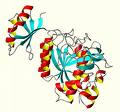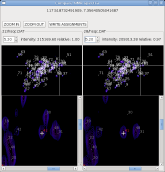 Visualize and Manipulate NMR spectra
Visualize and Manipulate NMR spectra

With burrow-owl you can analyze, manipulate, and visualize nuclear magnetic resonance (NMR) spectra. Burrow-owl was designed with protein NMR in mind, but can be used with any type of NMR data. In addition to standard features like contour plotting, burrow-owl incorporates the higher-order spectrum principle, a way of identifying correlated peaks in multiple spectra without the need for peaklists. The name burrow-owl continues the tradition of naming programs used in structure determination after birds, started by the program Coot. Burrow-owl and Coot are similar in some ways:
There are also some important differences:
You can download the latest source code release from the project page. It's also available in the Gentoo Linux distribution. Please tell us about your experiences porting it to other platforms.
For support, send a message to the developers at burrow-owl-devel@lists.sourceforge.net
If you just want to download a recent working version, download a recent release. You will also need to have the starparse and guile-gnome libraries installed. If you want to hack burrow-owl, keep reading.
The source code is maintained as a git repository. To get a copy, install git and run this:
$ git clone git://burrow-owl.git.sourceforge.net/gitroot/burrow-owl/starparse $ git clone git://burrow-owl.git.sourceforge.net/gitroot/burrow-owl/burrow-owl
Since git is a distributed version-control system, your checkout is a full, standalone copy of the original repository with complete history.
To use burrow-owl, you must have one or more NMR spectra, a script, and (optionally) a list of chemical shift assignments.
Spectra must be in NMRPipe format (in the future there may be support for other formats as well.) Three-dimensional spectra must be contained in a single file- i.e. burrow-owl does not support 3D spectra stored as separate files for each plane. You must concatenate such collections to a single file. For example, if you had a 3D spectrum stored as planes test001.ft2, test002.ft2, etc., you would run:
$ xyz2pipe -in test%03d.ft2 > my-3d-spectrum.DAT
Burrow-owl is very flexible-- scripts are used to specialize it to particular data analysis tasks. To see what scripts are available, type at the command prompt:
$ burrow
Scripts are invoked by giving their name as a sub-argument. Most take additional arguments, such as names of spectrum data files. For example:
$ burrow viewer hsqc.DAT
Scripts are written in the Scheme programming language. A standard set of scripts is included in the distribution, and you can write your own too.
Burrow-owl reads and writes chemical shift assignment files in the BioMagResBank format, which is suited to both automated processing and editing by hand.
 Example 1 |
 Example 2 |
 Example 3 |
| Comparing two-dimensional spectra |
Viewing sections of three-dimensional spectra |
Protein backbone assignments |